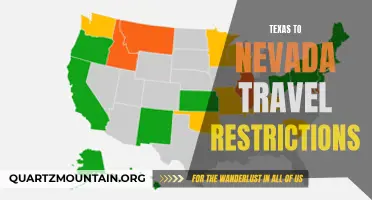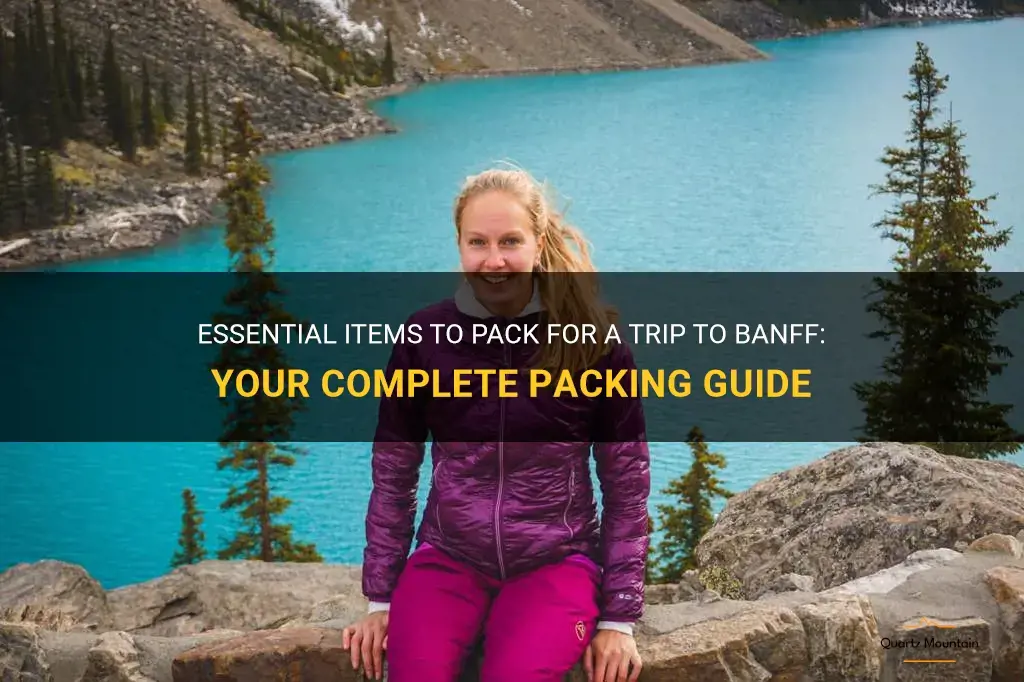
Are you planning a trip to Banff and feeling overwhelmed with what to pack? Look no further! In this complete packing guide, we will break down all the essential items you need to have for a memorable and stress-free trip to one of Canada's most breathtaking natural wonders. From outdoor gear to cozy essentials, we have got you covered. So, grab your notebook and get ready to pack your bags for an unforgettable adventure in Banff!
| Characteristics | Values |
|---|---|
| Weather | Cold, unpredictable, can change quickly |
| Clothing | Layered clothing, thermal underwear, fleece jackets, waterproof outerwear, hats, gloves, warm socks |
| Footwear | Sturdy hiking boots, warm socks, thermal insoles |
| Accessories | Backpack, sunglasses, sunscreen, insect repellent, water bottle, camera |
| Hygiene products | Toothbrush, toothpaste, shampoo, soap, hand sanitizer |
| First aid kit | Band-aids, bandages, antiseptic wipes, pain reliever, tweezers |
| Navigation tools | Map, compass, GPS device |
| Camping equipment | Tent, sleeping bag, camping stove, cooking utensils, camping mat |
| Food and water | Non-perishable food, snacks, water purification tablets |
| Miscellaneous items | Portable charger, extra batteries, rain cover for backpack, cash, ID, travel documents |
What You'll Learn
- What are the essential items to pack for a trip to Banff National Park?
- Are there any specific clothing items or gear that are recommended for outdoor activities in Banff?
- What types of footwear should I bring for hiking in Banff?
- Is it necessary to bring any specialized equipment for wildlife encounters in Banff?
- Are there any items that should be included in a first aid kit for a trip to Banff?

What are the essential items to pack for a trip to Banff National Park?
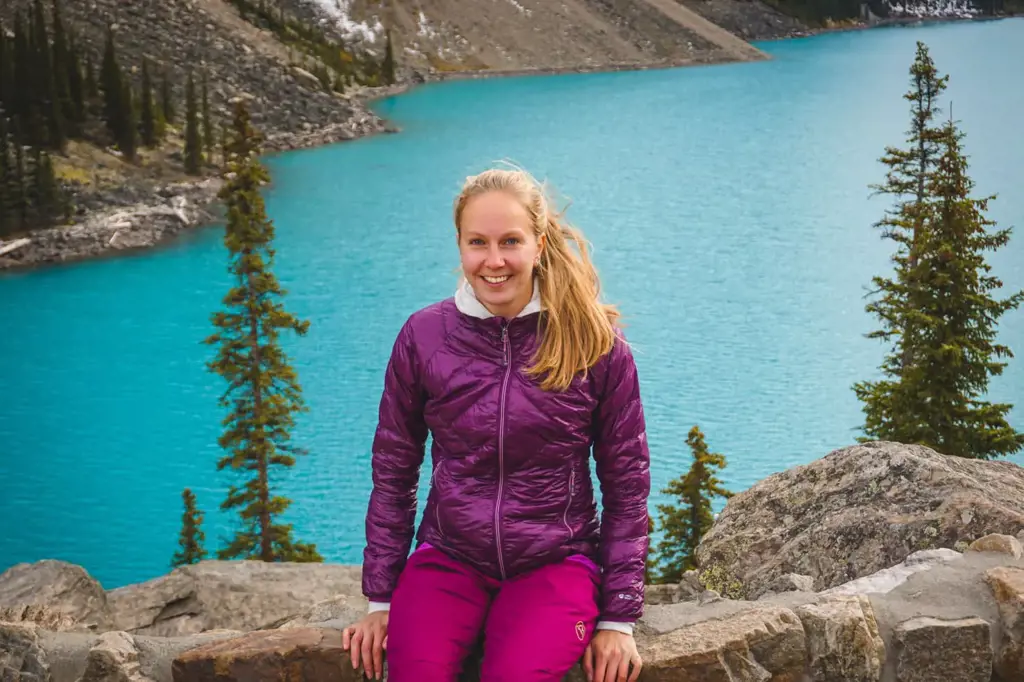
Banff National Park is a breathtaking destination located in the Canadian Rockies. Known for its stunning landscapes, crystal-clear lakes, and abundant wildlife, it attracts millions of visitors each year. If you're planning a trip to Banff National Park, it's essential to pack the right items to ensure you have a safe and enjoyable experience. Here are some of the must-have items you should consider bringing with you.
- Hiking Gear: Banff National Park is a hiker's paradise, with countless trails to explore. Make sure to pack a sturdy pair of hiking boots or shoes for comfortable trekking. Don't forget to bring appropriate clothing for the weather conditions, including layers for cooler temperatures and rain gear for unexpected showers. A backpack with essentials such as a water bottle, snacks, a compass, a map, and a first aid kit should also be included.
- Bear Spray: Banff National Park is home to a significant population of grizzly and black bears. While encounters are rare, it's crucial to be prepared. Carry bear spray, a deterrent designed to ward off bears, and learn how to use it properly. Remember to make noise while hiking to alert bears of your presence and reduce the chances of surprising them.
- Camera and Binoculars: Banff National Park offers stunning landscapes and wildlife viewing opportunities. Bring a camera to capture the beauty around you. Consider packing binoculars to get a closer look at the wildlife, including elk, moose, bighorn sheep, and birds. Be respectful of the animals and maintain a safe distance.
- Insect Repellent and Sunscreen: Mosquitoes and blackflies can be a nuisance, especially during the summer months. Pack insect repellent to keep these pesky bugs away. Additionally, don't forget to apply sunscreen regularly, as the sun's rays can be strong, even at higher altitudes.
- Water and Snacks: It's important to stay hydrated while exploring Banff National Park, as dehydration can occur quickly, especially at higher elevations. Carry a reusable water bottle and refill it at the various water stations available throughout the park. Pack energy-rich snacks to keep you fueled during your adventures.
- Camping Gear: If you plan on camping in Banff National Park, ensure you have all the necessary camping gear. This includes a tent, sleeping bag, sleeping pad, cooking utensils, and food supplies. Follow all camping regulations and consider booking your campsite in advance, as they can fill up quickly, especially during peak season.
- Maps and Guidebooks: While your smartphone may have GPS capabilities, it's always a good idea to carry physical maps and guidebooks of the park. These can provide valuable information on hiking trails, viewpoints, and points of interest. Familiarize yourself with the park's layout and be prepared for areas with limited cell service.
- Clothing for All Seasons: Banff National Park experiences a wide range of weather conditions throughout the year. Even during the summer, temperatures can dip at higher elevations, so bring warm clothing layers. During the winter months, pack thermal clothing, hats, gloves, and a good quality winter jacket to stay warm in the sub-zero temperatures.
- Respect for Nature: While not an item you can pack, it's essential to have respect for the natural environment when visiting Banff National Park. Follow all park rules and regulations, including proper waste disposal and respecting wildlife and their habitats. Leave no trace by minimizing your impact on the ecosystem.
By packing these essential items, you'll be well-prepared for your trip to Banff National Park. Remember to check the park's website for any additional recommendations or special considerations based on the current weather conditions or season. Enjoy your time in this beautiful and awe-inspiring destination!
Essential Gear for a Kokoda Trek: What to Pack for the Adventure
You may want to see also

Are there any specific clothing items or gear that are recommended for outdoor activities in Banff?
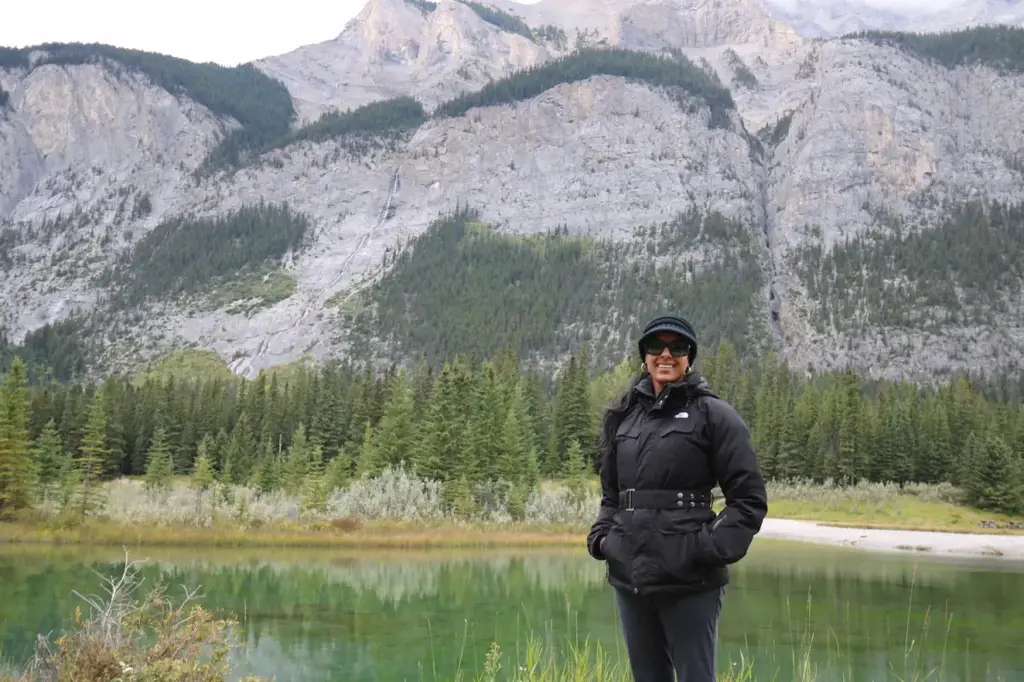
When planning outdoor activities in Banff, it is crucial to be well-prepared with the right clothing and gear. The weather in Banff can be unpredictable, with temperature fluctuations and sudden changes in conditions, so it is essential to dress in layers and have the appropriate gear for outdoor pursuits. Here are some recommended clothing items and gear for outdoor activities in Banff:
- Layered Clothing: Banff experiences varying weather conditions, even during the summer months. It is advisable to wear moisture-wicking base layers, such as thermal shirts and leggings, to keep your body dry and insulated. Over the base layers, wear a lightweight fleece or synthetic mid-layer for added warmth. Finally, a waterproof and windproof outer layer, like a shell jacket and pants, will protect you from rain, snow, and winds.
- Insulated Jacket: Banff can get cold, especially during spring and fall, so having a good quality insulated jacket is essential. Look for jackets with down or synthetic insulation that provide warmth without adding too much bulk. These jackets are lightweight, compressible, and offer excellent insulation even in extreme conditions.
- Hiking Boots: Since Banff offers numerous hiking trails, it is crucial to have proper footwear. Invest in sturdy hiking boots with good ankle support and traction. Waterproof boots will keep your feet dry during wet conditions or when crossing streams. Make sure to break in your boots before your trip to prevent blisters and discomfort.
- Waterproof Gloves and Hiking Socks: Cold and wet hands can quickly ruin your outdoor experience. Opt for waterproof gloves that offer insulation and dexterity. Look for gloves that are specifically designed for outdoor activities like hiking or skiing. Also, invest in high-quality hiking socks that wick away moisture and keep your feet warm. Merino wool socks are an excellent option as they are breathable, moisture-wicking, and offer natural insulation.
- Hat and Sunglasses: Protecting yourself from the sun's harmful rays is crucial in Banff's high-altitude environment. Wear a hat with a wide brim to shield your face and neck from the sun. Additionally, bring sunglasses that offer UV protection to protect your eyes from glare and harmful radiation.
- Backpack: A good quality backpack is essential for carrying your gear, food, water, and other essentials. Look for a backpack with a comfortable harness system and enough capacity to hold all your belongings. Make sure it has compartments and pockets for easy organization and accessibility.
- Safety Gear: Depending on the activities you plan to do, specific safety gear may be required. For example, if you are planning to go hiking, it is essential to have a map, compass, and a first aid kit. Additionally, if you are engaging in water-related activities, such as kayaking or rafting, a personal flotation device (PFD) is mandatory.
Remember, the specific clothing and gear you need will depend on the activities you plan to do and the time of year. It is always a good idea to check the weather forecast and consult local experts or guides for recommendations. Proper clothing and gear not only enhance your comfort but also ensure your safety during outdoor activities in Banff.
Essential Items for Your Feastcrate Packing List
You may want to see also

What types of footwear should I bring for hiking in Banff?
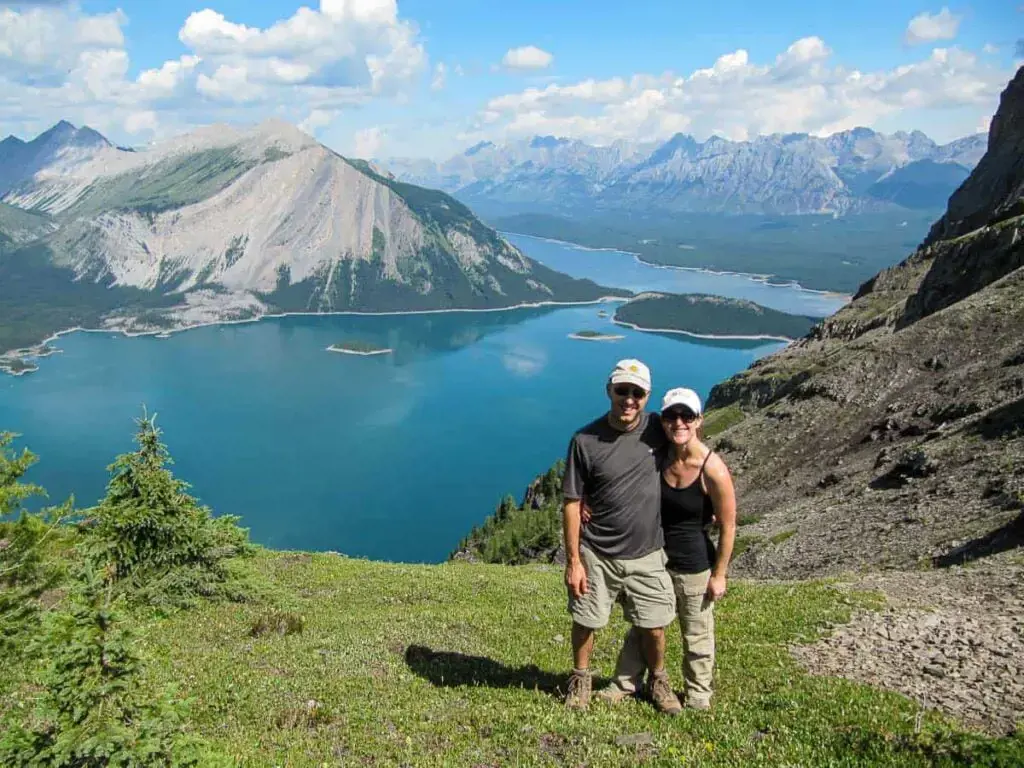
If you're planning a trip to Banff and you're looking forward to exploring the stunning hiking trails in the area, it's important to pack the right footwear. Hiking in Banff can be a challenging activity, and having the appropriate footwear can make all the difference in terms of comfort and safety. Here are some types of footwear you should consider bringing for hiking in Banff:
- Hiking Boots: When it comes to hiking in Banff, a good pair of hiking boots is essential. Look for boots that provide ankle support and have a sturdy sole with good traction. Waterproof or water-resistant boots are also a good option, as the trails in Banff can be wet and muddy, especially after rainfall or during spring. Make sure the boots fit well and are broken in before your trip to avoid blisters and discomfort.
- Trail Running Shoes: If you prefer a lighter option, trail running shoes can be a good alternative to hiking boots. These shoes are designed for running on uneven terrain and provide excellent grip. They are lightweight and flexible, making them comfortable for long hikes. However, trail running shoes may not provide as much ankle support as hiking boots, so consider your hiking style and the difficulty of the trails you plan to tackle.
- Hiking Sandals: If you're planning to hike in the summer months or on less challenging trails, hiking sandals can be a good choice. They offer breathability and keep your feet cool during hot weather. Look for sandals with a sturdy sole and good arch support to provide stability and prevent foot fatigue. Note that hiking sandals may not be suitable for muddy or wet conditions, so check the weather forecast and trail conditions before opting for this footwear.
- Gaiters: Regardless of the type of footwear you choose, it's a good idea to pack gaiters, especially if you're hiking in Banff during the spring or summer. Gaiters are protective coverings that wrap around your lower legs and feet, preventing debris such as rocks, mud, and water from entering your shoes. They can help keep your feet dry and protect your ankles from scratches and insect bites.
Remember, the type of footwear you choose will depend on the difficulty of the trails you plan to hike, the weather conditions, and your personal preferences. It's always a good idea to research the specific trails you'll be hiking in Banff to get an idea of the terrain and the conditions you'll encounter. Additionally, try on different types of footwear and walk around in them to ensure they fit comfortably and provide the support you need.
In conclusion, when hiking in Banff, it's important to bring appropriate footwear that provides comfort, support, and protection. Hiking boots, trail running shoes, and hiking sandals can all be viable options depending on the terrain and weather conditions. Don't forget to pack gaiters to protect your feet and lower legs from debris. With the right footwear, you'll be well-prepared to enjoy the breathtaking hiking trails in Banff.
Essential Gear and Supplies for Every Runner's Packing List
You may want to see also

Is it necessary to bring any specialized equipment for wildlife encounters in Banff?
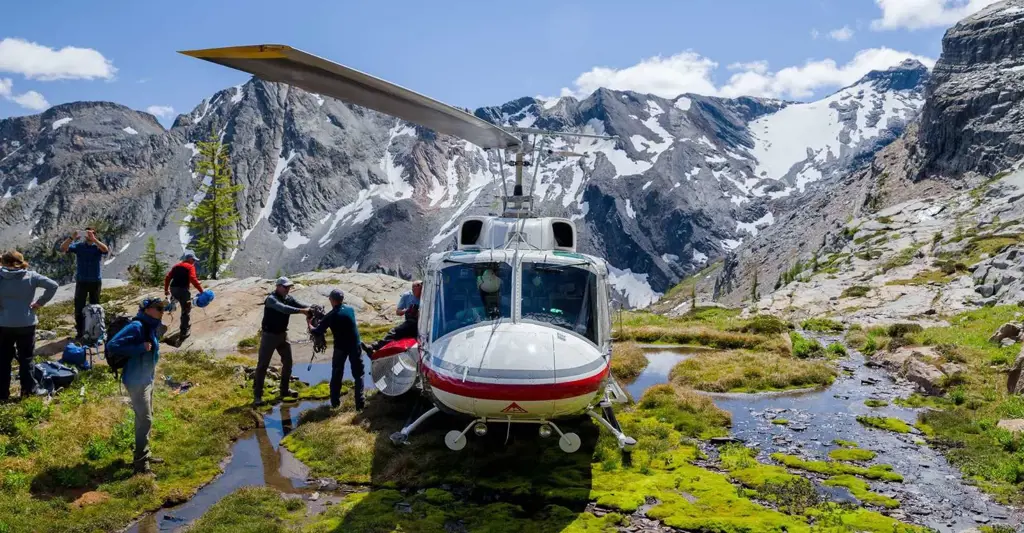
When planning a trip to Banff, many people are excited by the prospect of encountering wildlife in its natural habitat. From the majestic elk to the elusive grizzly bear, the Canadian Rockies are home to a diverse range of animals. While heading out into the wilderness to observe these creatures can be an unforgettable experience, it's important to be prepared. In this article, we will discuss whether it is necessary to bring any specialized equipment for wildlife encounters in Banff.
First and foremost, it is crucial to prioritize safety when encountering wildlife. While the animals in Banff National Park are generally accustomed to the presence of humans, they are still wild creatures and should be treated with respect. One essential piece of equipment to bring is bear spray. This specialized deterrent can help ward off aggressive bears and offers a sense of security when exploring the park. It is important to learn how to use bear spray correctly, so make sure to familiarize yourself with the instructions before your trip.
In addition to bear spray, another useful piece of equipment to consider is a pair of binoculars. Banff offers vast, panoramic views, and having binoculars can greatly enhance your wildlife spotting experience. Whether you're watching a herd of bighorn sheep gracefully traverse a mountainside or observing a golden eagle soaring high above, binoculars allow you to appreciate the intricate details of nature from a distance. They also allow you to observe animals without disturbing them, which is crucial for their wellbeing.
While specialized equipment can enhance your wildlife encounters in Banff, it's important to remember that the animals are the stars of the show. Observing them from a safe and respectful distance is key. It can be tempting to get a closer look or snap a photo, but it is crucial to prioritize their welfare and follow park regulations. Familiarize yourself with the guidelines for wildlife viewing and always keep a safe distance to prevent stress or harm to the animals and yourself.
Finally, it's worth noting that patience and keen observation are perhaps the most important tools you can bring for wildlife encounters in Banff. Animals may not always appear on cue, and it can require some waiting and watching to spot them. Take the time to sit quietly in areas known for wildlife activity, such as meadows or watering holes, and scan the surroundings for any signs of movement. With patience and a curious eye, you may be rewarded with an incredible wildlife sighting.
In conclusion, when heading to Banff for wildlife encounters, it is necessary to bring some specialized equipment such as bear spray and binoculars. These tools can enhance your safety and overall experience while respecting the wildlife. Remember to prioritize safety, keep a safe distance from the animals, and follow park regulations. Additionally, patience and keen observation are valuable assets for spotting wildlife in Banff. So pack your equipment, be respectful, and get ready for an unforgettable wildlife adventure in the Canadian Rockies.
Essential Items to Pack for a Memorable Dunham Trisigma Experience
You may want to see also

Are there any items that should be included in a first aid kit for a trip to Banff?
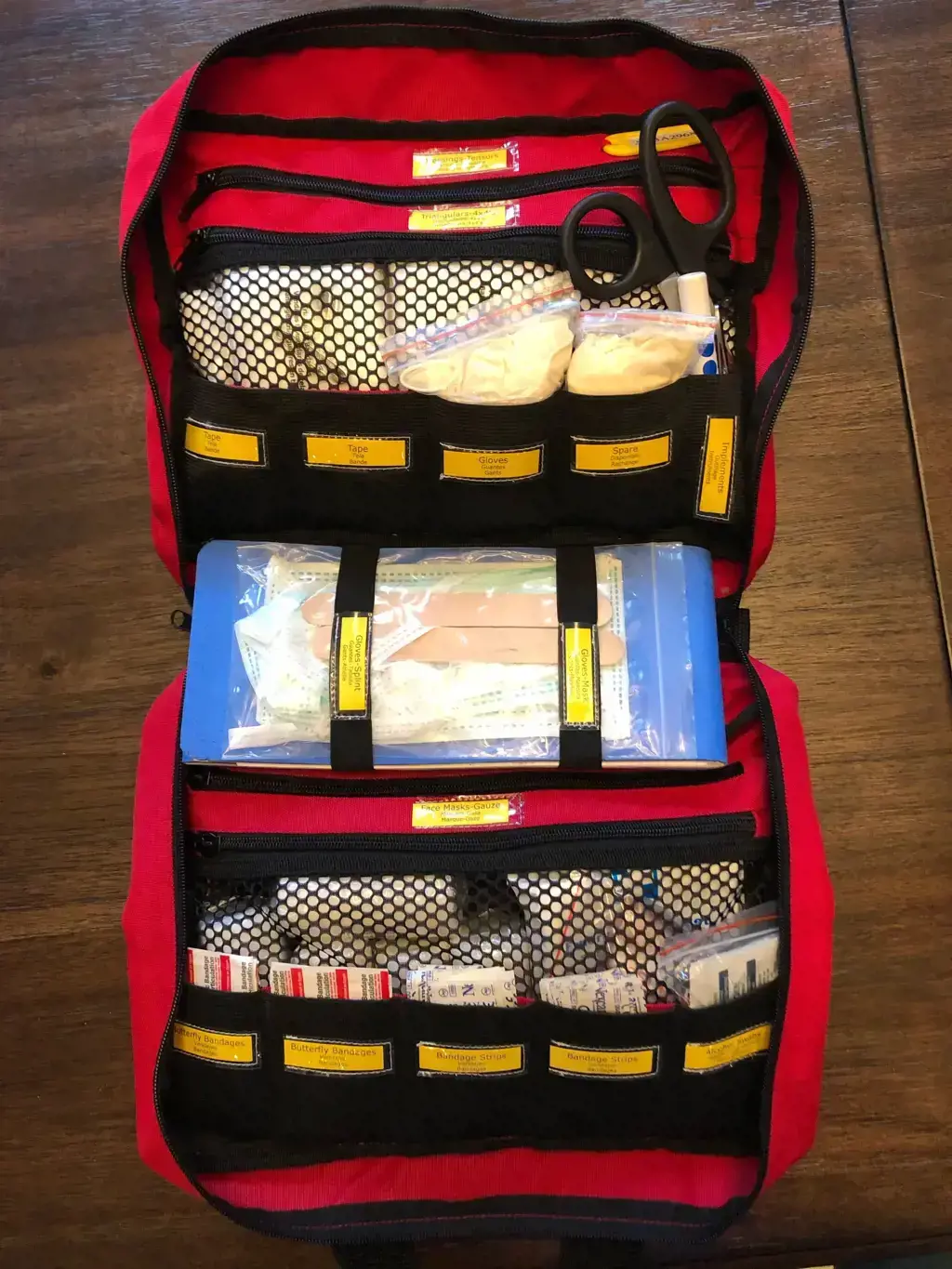
A first aid kit is an essential item to have on any trip, and this is especially true when visiting remote or wilderness areas such as Banff National Park in Canada. While Banff is known for its breathtaking scenery and opportunities for outdoor adventure, it's important to be prepared for any potential medical emergencies that may arise. Here are some items that should be included in a first aid kit for a trip to Banff:
- Bandages and adhesive tape: These are must-haves for treating cuts, scrapes, blisters, or any other minor skin injuries that may occur during your trip. Ensure that you have a variety of sizes and shapes of adhesive bandages to cover different wounds.
- Antiseptic solution or wipes: These can be used to clean wounds and prevent infection. In areas such as Banff, where there may be limited access to medical facilities, it's crucial to keep wounds clean to avoid any complications.
- Pain relievers: Over-the-counter pain medications such as acetaminophen or ibuprofen can come in handy for relieving minor aches and pains that may occur during your trip. These can also be used to manage any fever that might arise.
- Tweezers and scissors: Tweezers are useful for removing splinters, ticks, or other foreign objects embedded in the skin. Scissors, on the other hand, can be used to cut clothing or bandages if needed.
- Antihistamines: In a wilderness area like Banff, encounters with insects or plants that cause allergic reactions are not uncommon. Antihistamines can help alleviate symptoms such as itching, swelling, or hives caused by allergic reactions.
- Cold pack: A cold pack can be used to reduce swelling or soothe minor burns or bruises that may occur during outdoor activities such as hiking or camping.
- Moleskin or blister cushions: These can provide relief and protection for blistered or chafed areas on the feet. This is particularly important considering the amount of walking and hiking that visitors to Banff may undertake.
- Emergency blanket: An emergency blanket, also known as a space blanket, is a compact, lightweight sheet made of heat-reflective material. It can be used to keep someone warm in case of hypothermia or to provide shade in extreme heat.
- Medical information and emergency contact numbers: It's important to carry a card or document with your medical history, any known allergies, and emergency contact information. This can be invaluable in case of a more serious medical emergency.
- Personal medication: If you take any prescription medication regularly, make sure to pack an ample supply for the duration of your trip. It's also a good idea to bring a copy of your prescription in case you need to refill it while in Banff.
Remember, while a well-stocked first aid kit is essential, it's also important to have basic knowledge of first aid procedures. Consider taking a basic first aid course before your trip to ensure you are prepared for any unexpected situations. Additionally, always check the expiry dates of the items in your first aid kit and replace any that have expired.
In conclusion, a first aid kit is a crucial item to include when packing for a trip to Banff. With the right supplies, you can be prepared to handle minor injuries or manage symptoms until professional medical help is available. Taking the time to assemble a well-stocked first aid kit can provide peace of mind and ensure a safe and enjoyable trip to this stunning wilderness destination.
Essential Items to Pack for Your Trip to L.A
You may want to see also
Frequently asked questions
When packing for a trip to Banff, it is important to remember that the weather can be quite unpredictable. It is always advisable to layer your clothing, as temperatures can vary greatly throughout the day. Be sure to pack warm, waterproof jackets, sweaters, and long-sleeved shirts, as well as a good pair of hiking boots. Additionally, don't forget to bring swimwear for the hot springs!
For outdoor activities in Banff, it is crucial to come prepared with the right gear. If you plan on hiking, make sure to bring a sturdy backpack, a hat to protect you from the sun, a map or GPS device, and plenty of water and snacks. If you are planning on camping, don't forget to pack a tent, sleeping bag, and appropriate cooking supplies. It is also a good idea to bring bug spray and sunscreen to protect yourself from the elements.
In addition to clothing and outdoor gear, there are a few other essentials you should pack for your trip to Banff. These include a camera to capture the stunning beauty of the area, a refillable water bottle to stay hydrated, a hat and sunglasses to protect yourself from the sun, a first aid kit in case of any emergencies, and any necessary medications. It is also helpful to bring a reusable bag or backpack for carrying any souvenirs or groceries you may pick up during your stay.




